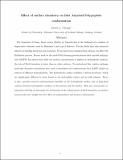| dc.contributor.author | Cheung, David L. | |
| dc.date.accessioned | 2020-09-09T13:35:08Z | |
| dc.date.available | 2020-09-09T13:35:08Z | |
| dc.date.issued | 2020-09-04 | |
| dc.identifier.citation | Cheung, David L. (2020). Effect of surface chemistry on islet amyloid polypeptide conformation. Biointerphases, 15(5), 051001. doi:10.1116/6.0000417 | en_IE |
| dc.identifier.issn | 1559-4106 | |
| dc.identifier.uri | http://hdl.handle.net/10379/16168 | |
| dc.description.abstract | The formation of dense, linear arrays (fibrils) by biomolecules is the hallmark of a number of degenerative diseases, such as Alzheimer s and type-2 diabetes. Protein fibrils have also attracted interest as building blocks for new materials. It has long been recognized that surfaces can affect the fibrillation process. Recent work on the model fibril forming protein human islet amyloid polypeptide (hIAPP) has shown that while the protein concentration is highest at hydrophobic surfaces, the rate of fibril formation is lower than on other surfaces. To understand this, replica exchange molecular dynamics simulations were used to investigate the conformations that hIAPP adopts on surfaces of different hydrophobicities. The hydrophobic surface stabilizes α-helical structures which are significantly different to those found on the hydrophilic surface and in bulk solution. There is also a greatly reduced conformational ensemble on the hydrophobic surface due to long-lived contacts between hydrophobic residues on the protein and the surface. This new microscopic information will help us determine the mechanism of the enhancement of fibril formation on surfaces and provides new insight into the effect of nanointerfaces and protein conformation. | en_IE |
| dc.description.sponsorship | Computational facilities for this work were provided by the SFI/HEA funded Irish Centre for High End Computing. Atomic structures for hIAPP in fibrils were provided by Robert Tycko (NIH). The author wishes to thank Kieran Somers for useful discussions during this work. | en_IE |
| dc.format | application/pdf | en_IE |
| dc.language.iso | en | en_IE |
| dc.publisher | American Institute of Physics | en_IE |
| dc.relation.ispartof | Biointerphases | en |
| dc.rights | Attribution-NonCommercial-NoDerivs 3.0 Ireland | |
| dc.rights.uri | https://creativecommons.org/licenses/by-nc-nd/3.0/ie/ | |
| dc.subject | surface chemistry | en_IE |
| dc.subject | islet amyloid polypeptide conformation | en_IE |
| dc.subject | Chemistry | en_IE |
| dc.subject | Protein structure | en_IE |
| dc.subject | Molecular dynamics | en_IE |
| dc.subject | Computational models | en_IE |
| dc.subject | Amyloids | en_IE |
| dc.subject | Data visualization | en_IE |
| dc.subject | Hydrophobic effect | en_IE |
| dc.subject | Polypeptide | en_IE |
| dc.subject | Surface and interface chemistry | en_IE |
| dc.subject | Diseases and conditions | en_IE |
| dc.subject | Biomaterials | en_IE |
| dc.title | Effect of surface chemistry on islet amyloid polypeptide conformation | en_IE |
| dc.type | Article | en_IE |
| dc.date.updated | 2020-09-08T15:24:53Z | |
| dc.identifier.doi | 10.1116/6.0000417 | |
| dc.local.publishedsource | https://doi.org/10.1116/6.0000417 | en_IE |
| dc.description.peer-reviewed | peer-reviewed | |
| dc.internal.rssid | 22586563 | |
| dc.local.contact | David Cheung, School Of Chemistry, Nuig. Email: david.cheung@nuigalway.ie | |
| dc.local.copyrightchecked | Yes | |
| dc.local.version | ACCEPTED | |
| nui.item.downloads | 480 | |


